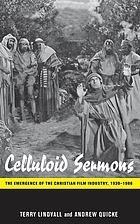 Visual Piety : a history and theory of popular religious images
by
David Morgan
Visual Piety : a history and theory of popular religious images
by
David Morgan
Publication Date: 1997-12-25
Rather than isolating popular icons from their social contexts or regarding them as merely illustrative of theological ideas, Morgan situates both Protestant and Catholic art within the domain of devotional practice, ritual, personal narrative, and the sacred space of the home. In addition, he examines how popular icons have been rooted in social concerns ranging from control of human passions to notions of gender, creedal orthodoxy, and friendship. Also discussed is the coupling of images with texts in the attempt to control meanings and to establish markers for one's community and belief.
 Celluloid Sermons : the emergence of the Christian film industry, 1930-1986
Celluloid Sermons : the emergence of the Christian film industry, 1930-1986
